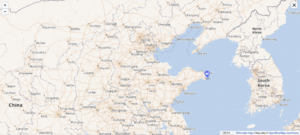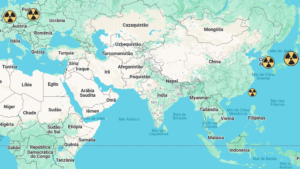- Four strategic sites of potential Chinese espionage which monitor US military activities were identified in Cuba;
- The discovery revives memories of the 1962 Cuban Missile Crisis;
- Potential Chinese espionage could lead the US to impose new sanctions against Cuba.
Suspicion that China is committing espionage against the United States, using Cuban territory, is bringing back memories of the 1962 Cuban Missile Crisis, when the world was on the brink of nuclear war.
Therefore, it is important to analyze the complex and often hypocritical power dynamics between the world’s largest nations, as well as the location and purpose of these spy bases and the geopolitical implications of this discovery.

What Are the Supposed Chinese Radar Bases in Cuba?
Recently, reports emerged about the presence of alleged Chinese radar installations in Cuba. These locations, identified by the Center for Strategic and International Studies (CSIS), would be used for espionage, monitoring United States military activities in the region.
Where are they located?
CSIS analysts have identified four main spy sites in Cuba:
- Bejucal: Located south of Havana, it is considered the largest active site and recently received new radar equipment.
- El Salao: Near the US naval base at Guantanamo Bay is a newly discovered site that can monitor nearby military activity.
- Wajay: This site has grown considerably over the years and now has multiple antennas.
- Calabazar: Another location with multiple antennas used to intercept signals.
As previously stated, Cuba’s proximity to the United States makes these spy bases particularly strategic. They can intercept communications and monitor US military movements, something that would be difficult to do directly from China.
A recent incident that illustrates concerns about Chinese espionage was the spy balloon that flew over the US. This balloon showed that China is active in collecting sensitive American information.
The presence of radar installations in Cuba can be seen as an extension of this espionage strategy, providing China with a privileged position to closely observe American military operations, especially in Florida, which is just a few kilometers from Cuba and is home to many American military installations. as well as the main rocket launch center at NASA (Cape Canaveral).
How Do Potential Chinese Espionage Bases in Cuba Rekindle the 1962 Cuban Missile Crisis?
The recent discovery of alleged Chinese spy facilities in Cuba has brought back memories of one of the most tense moments of the Cold War: the Cuban Missile Crisis of 1962. Although the current situation does not involve nuclear missiles, there are parallels that cause concern.
In 1962, the Soviet Union installed nuclear missiles in Cuba, just 90 miles (145 km) off the coast of the United States. However, this crisis must also be understood in the context of previous tensions, including the presence of American nuclear missiles in Turkey, which directly bordered the former Soviet Union.
Before 1962, the United States had placed medium-range ballistic missiles known as Jupiter in Turkey, a NATO member and important strategic ally.
These missiles were positioned a short distance from Soviet territory, allowing the United States the ability to launch a nuclear strike directly into the heart of the Soviet Union in a short space of time.
This movement provoked a serious crisis, with President John F. Kennedy ordering a naval blockade and threatening military action. The world stood on the brink of nuclear war until a behind-the-scenes agreement (not released to the public at the time) was reached to remove the missiles from both Cuba and Turkey.
3 Parallels With the Current Situation:
- Geographic Proximity: As in 1962, Cuba’s proximity to the United States is a critical factor. Chinese spy bases in Cuba offer China a unique opportunity to closely monitor US military activities, something impossible from its own territory.
- Threat to National Security: The presence of spy facilities so close to the US is seen as a threat similar to what Soviet missiles posed at the time. These facilities can intercept communications and monitor military movements, providing China with valuable information.
- US Response: During the Missile Crisis, the US responded with a naval blockade and threats of military action. Today, although the responses may be different, the discovery of spy bases could lead to diplomatic and military measures to neutralize the threat.
What Types of Military or Intelligence Bases Does the US Have Near China?
While the United States expresses concern about alleged Chinese spy facilities in Cuba, it is important to remember that the United States also maintains a strong military presence near China’s borders.
This presence includes military bases and strategic intelligence systems, showing a certain hypocrisy in the American stance.
Major US Bases and Installations Near China:
- South Korea: THAAD (Terminal High Altitude Area Defense) System: This missile defense system is designed to intercept ballistic missiles originating from North Korea, but can also monitor Chinese military activity. The presence of THAAD in South Korea has been a point of tension between the US, China and North Korea.
- Japan: Japan is home to several American military bases, including Yokota Air Base and the Naval Base from Yokosuka. These facilities allow the US to project military power in the region and monitor activities in China and the Western Pacific.
- Guam: This Pacific island is a strategic base for the U.S. military, with air and naval facilities that support operations throughout the Asia-Pacific region. Andersen Air Force Base and Guam Naval Base are critical points for the American military presence a little further away from China, but still in a sensitive region.
- Philippines: The US maintains defense agreements that allow for the rotational presence of American forces in the Philippines. This includes access to bases and ports, increasing the U.S. ability to quickly respond to crises in the region.
However, the American stance, while criticizing Chinese actions, mirrors the US’s own actions in the Pacific.
What are the Geopolitical Consequences of Alleged Chinese Espionage Bases in Cuba?
The discovery, if confirmed to actually be Chinese spy facilities, could have strong geopolitical consequences, worsening tensions between the US and China, and also changing the security dynamics in the Caribbean region.
Reinforcement of the US military presence in the region: In response to the alleged Chinese bases, the US may decide to reinforce its military presence in the Caribbean and Latin America. This could include sending more ships, planes and troops to the region, as well as increasing surveillance and military exercises. Such a move aims to ensure that the US can quickly respond to any perceived threat.
Impact on US-Cuban Relations: The discovery of the bases could further complicate the already tense relations between the US and Cuba. Since the rapprochement during the Obama administration, bilateral relations have deteriorated again. Cuba’s collaboration with China in espionage activities could lead to new economic and diplomatic sanctions by the US.
Escalation of Information Warfare: The alleged spy bases also indicate an escalation in information warfare between the superpowers. With the US alleging Chinese espionage and taking steps to protect itself, both countries may intensify their cyberespionage and intelligence activities, increasing the possibility of cyberattacks and disinformation.
International Response: Other nations, especially U.S. allies in NATO and Asia, may react to China’s growing influence in the West.
Worsening relations between the two powers: In addition to spy bases, the US and China are already at odds for other reasons, such as trade disputes and previous espionage incidents, such as the Chinese balloon that flew over the rival country. Diplomatic tensions could intensify, even leading to the cancellation of bilateral relations and increasing the risk of indirect conflicts (proxy wars), which have the potential to escalate into conventional or even nuclear confrontations.








Be First to Comment